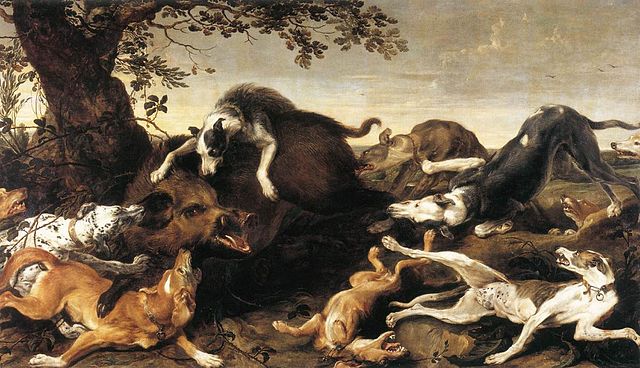
July 17, 2014, by Harry Cocks
Rewilding: the Natural History of Wild Boar in Northern Italy
Can a landscape be taken “back in time” to a state before agriculture in which natural species of flora and fauna re-emerge spontaneously? This process of “rewilding,” in which animal and plant populations specific to some pre-human past manage themselves through predation and death, has been tried most famously in the unlikely location of the densely populated Netherlands. At the Oostvaardersplassen nature reserve on a reclaimed polder north-east of Amsterdam, 6000 hectares of marsh and grasslands has been returned to a state which was supposed to have obtained in Europe after the last ice age. Instead of being covered by dense virgin forest, as historians used to think, the post-ice age landscape of c. 8000 years ago was more like an open savanna populated by birds, large grazing animals such as massive Aurochs cattle and packs of horses. Rewilding has also been tried on a less ambitious form at Ennerdale in the Lake District, where natural processes are used to allow changes to 4300 hectares of upland woodland.
However, these schemes are not always uncontroversial. This is true of the partly deliberate and partly natural reintroduction of the wild boar to the Val di Vara region of Italy some 70 km northeast of Genoa. In a new article for the Journal of Rural Studies (see link below) Ross Balzaretti, Associate Professor of Medieval History at Nottingham, Robert Hearn, a former Ph.d Student in the department and now post-doc at University of Genoa, and Charles Watkins, Professor of Geography at Nottingham, examine how the process of species reintroduction took place and address some of the issues raised by the return of the wild boar to this region through oral history interviews with local people about their interactions with the boars.
Boars were once plentiful in the region and are often referred to in medieval and early modern sources (as above right in Frans Synders’ Wild Boar Hunt, c. 1630). Their decline is generally held to have resulted from the rise of intensive agriculture and corresponding population growth in the nineteenth century. The “last boar” was said to have been killed in 1814 at Bardineto near Savona, though other sources date the species’ disappearance to the late eighteenth century. However, after a century of absence, the boars returned to north western Italy after World War I and a boar weighing in at 100 kg was shot near Albenga in 1919. The animal’s fortunes improved still further after 1945 when rural depopulation and the abandonment of agricultural land led to the regeneration of woodland thereby creating a habitat in which boars could flourish.
Hunting boars revived in the 1960s, with the first boars killed around 1967. As one farmer’s wife recalled of her husband, who at the time was probably one of the first to bag a reintroduced boar, “he was jumping up and down with excitement because he had just killed a wild boar!” However, culinary knowledge of how to cook the beast had disappeared with the animals themselves, and another farmer, when recalling a kill, remembered that “no one knew how to cook it, but they ate it nonetheless, half raw, half cooked!”
Hunting was encouraged by the locals as the boar had significant impact on agriculture in the region through rooting for food, eating and grubbing up vineyards and destroying much cherished wild mushrooms. This also led to an interest in maintaining a certain level of boar population in order to provide quarry.
The authors conclude that the wild boar has taken advantage of rural depopulation – a sort of rewilding through neglect – through its ability to survive in unmanaged countryside, but that rewilding in this case is a process of human-boar interactions rather than a simple abandonment of the landscape to a notional pre-human past.
Balzaretti, Hearn and Watkins, “The cultural and land use implications of the reappearance of the wild boar in the North West Italy: A case study of the Val di Vara.”
http://www.sciencedirect.com/science/article/pii/S0743016714000710
No comments yet, fill out a comment to be the first

Leave a Reply